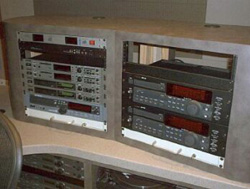| WBAA Studio Remodel The 2001 studio remodel for WBAA-AM and WBAA-FM at Purdue University was one of my proudest accomplishments. Being an NPR affiliate as well as Indiana’s oldest continuously operating radio station meant there was a lot of history here. Working together with Russ Berger Design Group as the acoustic consultants, we achieved an extremely functional design with a lot of character and class.Serving as design engineer for all the electronic systems as well as project manager for installations presented some interesting design challanges to overcome. While I had an installtion crew that worked for me at the University, this time I got in there side by side with them to make sure everything was done to my high standards.The result was a facility that rivaled that of much larger markets and one the University could be proud of.Below are some photos of the project from the beginning demolition to the finished studios. To the right is an article featuring the design in a popular trade publication. |
 The Studio Spotlight The Studio SpotlightJul 1 2001Radio Magazine has a regular feature exibiting the best broadcast studios in the country. The studio facility I helped design alongside Russ Berger Design Group was chosen and featured in this article. (PDF) read it… (Web) Read it… |
| Rendering and Fly-through Very early in the process I took the plans developed in conjunction with Russ Berger Design Group and rendered them in 3D. Finishes had not been selected at the time of this rendering, therefore the finishes and furniture in this rendering were developed to accentuate the characteristics of the rendering.VIEW THE FLYTHROUGH! |
 |
Photo Gallery
 All good projects need a good set of plans! All good projects need a good set of plans! |
 Elliot Hall of Music, Purdue University Elliot Hall of Music, Purdue UniversityOne of the main challenges of this project was the fact that the studios were being built directly below the main floor of a 6025 seat theater commonly used for concerts and other convocations. |
||
 The slab was cut to be excavated so the raised floor of the techical operations center would be at the same level as the rest of the floor. The slab was cut to be excavated so the raised floor of the techical operations center would be at the same level as the rest of the floor. |
 Forms and fresh pour for the sides Forms and fresh pour for the sidesof the Technical operations center recessed floor. |
||
 The raised floor was installed in the technical operations center 14 inches lower than the main floor so the floor would be level with the rest fo the facility. The raised floor was installed in the technical operations center 14 inches lower than the main floor so the floor would be level with the rest fo the facility. |
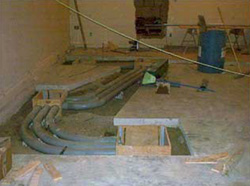 Forms and conduit for wiring Forms and conduit for wiringbetween the studios and the technical operations center. |
||
  After the studio walls were studded out, double layers of drywall went up with acoustic sealant between each seam. All walls were isolated from each other for maximum sound isolation. After the studio walls were studded out, double layers of drywall went up with acoustic sealant between each seam. All walls were isolated from each other for maximum sound isolation. |
 Solid maple flooring for the studios Solid maple flooring for the studiosgets installed over the slab. |
||
 The walls were prepared for sound absorption. The sound absorption used was nearly 4″thick fiberglass panels with a final fabric covering. The walls were prepared for sound absorption. The sound absorption used was nearly 4″thick fiberglass panels with a final fabric covering. |
 The maple flooring was installed to appear to flow from one studio to the other through what would eventually be a large double pane of glass that goes right to the floor. The large wiring access hole will be covered by the furniture once installed. The maple flooring was installed to appear to flow from one studio to the other through what would eventually be a large double pane of glass that goes right to the floor. The large wiring access hole will be covered by the furniture once installed. |
||
 RPG diffusors were used on the rear wall in the two main studios. The finish was designed to match the maple floor. Note the surrounding absorption system has been covered with the fabric finish. RPG diffusors were used on the rear wall in the two main studios. The finish was designed to match the maple floor. Note the surrounding absorption system has been covered with the fabric finish. |
 Before the furniture arrived, all the prewiring was performed with the wiring blocks stored below the floor. Before the furniture arrived, all the prewiring was performed with the wiring blocks stored below the floor. |
||
 Now the place was starting to look like a studio! The floor was covered for protection but the walls were finished and the glass was in. Now the place was starting to look like a studio! The floor was covered for protection but the walls were finished and the glass was in. |
 Furniture components arrived from Furniture components arrived fromMager Systems, a broadcast furniture designer and manufacturer located in Pheonix, Arizona. |
||
 Some of the furniture components were extremely large, especially the single slab solid surface countertops used in the voice studios. Some of the furniture components were extremely large, especially the single slab solid surface countertops used in the voice studios. |
 An installer from Mager Systems An installer from Mager SystemsAssembles the furniture. |
||
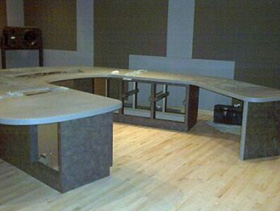 The completion of the main studio furniture base marked a real milestone in the project. The studios were nearing completion. Meanwhile, my team was working in the next room to install the core broadcast equipment in the tech center. The completion of the main studio furniture base marked a real milestone in the project. The studios were nearing completion. Meanwhile, my team was working in the next room to install the core broadcast equipment in the tech center. |
 |
||
 I really enjoyed working side-by-side with my team on this one. Could that cell phone be any larger? That alone dates this project! I really enjoyed working side-by-side with my team on this one. Could that cell phone be any larger? That alone dates this project! |
 The core routing engines and audio distribution was installed in the rack. The core routing engines and audio distribution was installed in the rack. |
||
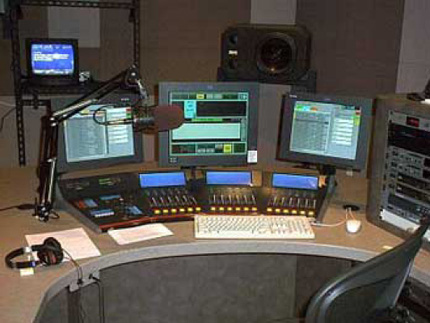 After installing the automation system, operations were cut over from the old facilities to the new studios. Being an NPR affiliate means having a lot of satellite programming, but also a lot of live interviews and original programming. The layout was designed to facilitate interviews to the side of the operator while allowing the operator to have full control of mic levels and other pre-recorded program elements. After installing the automation system, operations were cut over from the old facilities to the new studios. Being an NPR affiliate means having a lot of satellite programming, but also a lot of live interviews and original programming. The layout was designed to facilitate interviews to the side of the operator while allowing the operator to have full control of mic levels and other pre-recorded program elements. |
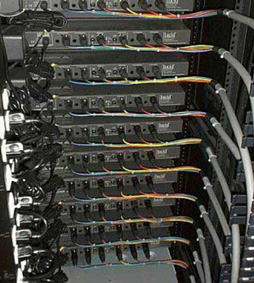 I always held my staff to very high I always held my staff to very highstandard of work. |
||
 Wide angle view of the completed studio. Wide angle view of the completed studio. |
Turntables with digital output were requiredfor Sunday Jazz programming.
|
||
 Connected to each main studio was a “voice” studio that could function as a fully operational air studio or, the mics could be controlled from the main control room. Connected to each main studio was a “voice” studio that could function as a fully operational air studio or, the mics could be controlled from the main control room. |
 Logitec Roc-10 console installed Logitec Roc-10 console installedin the “voice” studio. |
||
 The waiting area outside the studios was almost finished. Carpet would not be installed until the second phase of the project. Once the carpet was installed and furniture put in place, it made a very nice “green room” The waiting area outside the studios was almost finished. Carpet would not be installed until the second phase of the project. Once the carpet was installed and furniture put in place, it made a very nice “green room” |
 Furniture in the “Green Room.” Furniture in the “Green Room.” |
||
 Once the second phase of the project was complete, the new reception desk was installed and the main entry to the facility gave visitors a stellar view of the Main Studio #1 and it’s voice studio. Once the second phase of the project was complete, the new reception desk was installed and the main entry to the facility gave visitors a stellar view of the Main Studio #1 and it’s voice studio. |
|||
| 2013 Note: As I look back on this project, I am amazed how far the industry has come technologically since then. Today, I would never run that much conduit in the floor because by using advanced Audio over IP technologies available from several manufacturers, I can handle an entire studio with only a hand-full of cat6 cables. Also, punch blocks are no longer required if a facility is built from the ground up using these newer technologies. However this was a very state of the art all-digital facility back in 2001 when an all digital studio was a rarity in the industry. | |||
